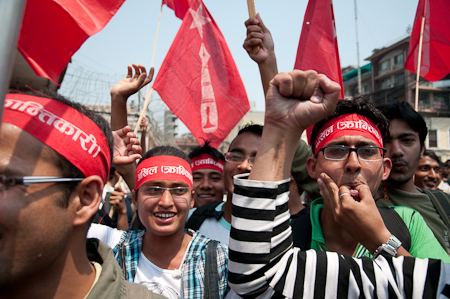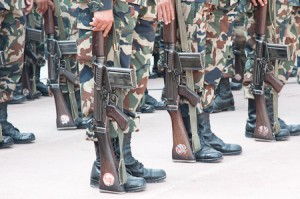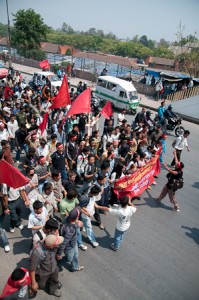“You must come to Kathmandu with shroud cloth
wrapped around your heads and flour in your bags. It will be our last
battle. If we succeed, we survive, else it will be the end of our
party."
— General Secretary Badal of the Unified Communist Party of Nepal (Maoist)
 |
| (Jed Brandt) |
|
There are moments when Kathmandu does not feel like a city
on the edge of revolution. People go about all the normal business of
life. Venders sell vegetables, nail clippers and bootleg Bollywood films from
the dirt, cramping the already crowded streets. Uniformed kids tumble
out of schools with neat ties in the hot weather. Municipal police
loiter at the intersections while traffic ignores them, their armed
counterparts patrol in platoons through the city with wood-stocked
rifles and dust masks as they have for years. New slogans are painted
over the old, almost all in Maoist red. Daily blackouts and dry-season
water shortages are normal for Nepal’s primitive
infrastructure, not the sign of crisis. Revolutions don’t happen outside
of life, like an asteroid from space – but from right up the middle,
out of the people themselves.
Passing through Kathmandu’s Trichandra college campus after meeting
with students in a nearby media program, I walked into the aftermath of
bloody attack. Thugs allied with the Nepali Congress party student group had
cut up leaders of a rival student group with khukuri knives
leaving one in critical condition. Hundreds of technical students were
clustered in the street when I arrived by chance. The conflict most
often described through the positioning of political leaders is breaking
out everywhere.
Indefinite bandhs [strikes] are paralysing large parts of the country
after the arrest of Young Communist League (YCL) cadre in the isolated
far west and Maoist student leaders in Pokhora, the central gateway to
the Annapurna mountain range. The southern Terai is in chaos, with
several power centres competing and basic security has broken down;
banditry, extortion and kidnapping are now endemic. Government ministers
cannot appear anywhere without Maoist pickets waving black flags and
throwing rocks.
With no central authority, all sides are claiming the ground they
stand on and preparing their base. It’s messy, confused and coming to a
sharp point as the May 28 deadline for a new constitution draws near
with no consensus in sight. The weak government holding court in the
Constituent Assembly can’t command a majority, not even of their own
parties. Seventy assembly representatives of the status quo Communist
Party of Nepal (United Marxist-Leninist) party signed a letter calling
on their own leader to step down from the prime minister’s chair to
make way for a Unified Communist Party of Nepal (Maoist) -- UCPN (M),
known simply as the Maoists -- national-unity government. He refuses,
repeating demands that the Maoists dissolve their popular organisations
and return lands seized by the people who farm them.
The Maoists have more pressing concerns than the legalism of the
parliamentary parties. If they can’t restructure the state, by
constitutional means or otherwise, the enthusiasm that brought their
revolutionary movement this far may turn to disillusionment. With no
progress in the assembly, the leaders of the status quo parties now
say there will be no resolution on time. The Maoists have rejected any
extension as a stalling tactic and are turning to the people. With
now-or-never urgency, they are mobilising all their forces for a
decisive showdown in Kathmandu.
Nepal braces for May 1
Posters for May 1 appeared overnight announcing the Maoist call
for workers and villagers to converge on Kathmandu for a “final
conflict”. The Maoists are calling for a sustained mobilisation, with
the hope that an overwhelming showing can push the government out with a
minimum of bloodshed and stay the hand of the Nepal army.
May 1 is International Workers' Day, the traditional day of action
for communists around the world, but the mobilisation has already
begun.
 |
| YCL members leading a labor contingent. (Jed Brandt) |
|
Thousands of recruits are being trained by YCL cadre in districts
throughout the country, drilling with bamboo sticks in place of rifles.
With threats from Nepal army commanders to put these protests down with
force, the Maoists are preparing to defend their mass organisations, the
marches, the party and the people from attempts at counter-revolution.
Their meetings include political orientations and anti-disinformation
training to combat the confusing fog of manufactured rumours and lies
that are already in the air.
National assemblies of radical students, artists, intellectuals,
ethnic federations, women, unions and trade organisations convened
widely during the month of April. All sectors are receiving the same
message: the Maoists will not return to the jungle, or replay a guerilla
struggle. They will not retreat. The conflict will be decided frontally
in the cities.
Dual power – class struggle at the tipping point
Nepal has two mutually exclusive power structures: one is the
revolutionary movement led by the Unified Communist Party of Nepal
(Maoist), which has a powerful mass base among the people, a disciplined
political militia in the YCL and its People’s Liberation Army. The
other is the apparatus of Nepal’s state — held over from the monarchy,
unreconstructed, backed by the rifles of the Nepal army and the heavy
weight of feudal tradition.
Land seizures co-exist with plantations. Old judges still sit in
their patronage chairs dispensing verdicts to the highest bidder while
revolutionary courts turn off and on in the villages. The deposed king
Gyanendra lost his crown, but retains vast tracts of land, a near
monopoly on tobacco and a “personal” business empire. Large-scale
infrastructure like hydropower remains largely under foreign ownership,
but only operates when, and how, the Maoist-allied unions let them. In
short, the semi-feudal, semi-colonial system of Nepal is in place but
the organised workers and Maoist-led villagers hold a veto.
In Nepal, people were taught that the poor would always be poor. They
long believed it. There would always be kings, lords, myriad deities
and foreign patrons to look over them. Caste dictated behaviour and
expectations for most, justifying dull cruelty and vast human waste. The
tolerance and fatalism so beloved by British travel writers were also
consigning the people of Nepal to isolation, ignorance and the lowest
life expectancies in Asia. But the world doesn’t actually stand still,
or turn in circles, as some would have it. Things do change.
When urban civil uprisings wrested a parliamentary system from King
Birendra in 1990 nothing changed for the people, save those whose hands
got greased for government services. When rising expectations crashed
into the closed doors of realpolitik of elite “democracy” – the Maoists
blew it open, building an army up from the people themselves. From
bases of support in Rolpa and Rukum, the People’s War spread to 80% of
the country in 10 lightening years. More than 10,000 people lost their lives in the
greatest uprising in Nepal’s history.
Yubaraj Lama, a prominent actor/director thrust into radical politics
by the movement against the king, put it simply: "It was the failure of
the political parties to bring democracy, any real social change for
the masses of people that fueled the People's War. This is what the
Maoists changed. People were very fatalistic, looking up to politicians
like princes. That is over."
 |
| Nepal Army soldiers at GP Koirala's funeral.(Jed Brandt) |
|
People who had never thought social change was possible now believe
they can end their poverty. Kings are not gods and their crown can fall.
Women and girls are more than a way to have male children. The heavy
hand of foreign domination and its imposed backwardness can be
challenged. The Maoists changed the concept of politics from
appeal-if-you-dare to revolution from the ground up.
Everyone isn’t happy with the way the wind is blowing. It is easy to
find haughty conservatives who think any hope from the poor comes at
their expense and who want to see the Maoists crushed.
Talking with the owner of an English-language bookstore, an outspoken
supporter of the CPN (UML)’s embattled prime minister, he insisted that people
only attended the Maoist rallies because they were forced to. This
plainly isn't true, but I asked why they won the elections. He told me
“these people are stupid” and “believe the Maoist lies that they can
live in the big house”. When I noted that all the unions in the
neighbourhood were Maoist and they hardly seemed forced into it, he
laughed. “Of course they are, they want to take all the money from
people who own them.”
With all the paranoia of the United States’ white-fright militias, Nepal’s
reactionaries conflate rudimentary democracy, let alone the communist
program of the Maoists, with the very end of the world.
Nepal’s embattled elites also can’t simply be brushed aside or
nuanced into reform. They to have an army, the former Royal Nepal Army,
renamed but unreconstructed. The officer corps is steeped in caste
ideology and disdain for the common people, supplied with modern
weapons and not-so-secret Indian and US advisers.
The PLA is training and waiting within UN-supervised cantonments –
military bases scattered across the countryside. The YCL, led by former
PLA commanders, is training new militias throughout the country. And for
its part, the Nepal army is confined to its barracks, concentrated in
and around Kathmandu.
The politics of this moment are intricate. Many forces parry and
maneouvre for advantage. But the basic situation is this: dual power has
produced a highly unstable stalemate between a revolutionary people and a
weakened regime – a paper tiger with real claws — and the moment of
decision is fast approaching.
Democracy is just a word
Over the last 20 years, passion has only grown to see the people
decide Nepal’s future, to have some form of genuine popular democracy.
It erupted first in the 1990 Jana Andolan civil uprising. It fueled the
People's War that started in 1996 and animated the powerful mass
movement that toppled the king in 2008.
 |
| Twenty years of struggle have produced a changed people.(Jed Brandt) |
|
One of the fruits of that sustained struggle was the current
Constituent Assembly – where elected representatives of the grassroots
were supposed to craft a new framework for a new society, with both open
election to seats and sectoral representation to ensure that women,
minorities and workers had direct representation. The very idea of such a
constituent assembly comes from communist demands – it was their answer
to bourgeois democracy.
Maoists made 40 demands of the king in the mid-1990s before launching
their guerrilla war. Despite consistent flexibility on almost
everything, a constituent assembly was the only demand that was never
negotiable. It’s profound, the idea of an empowered assembly drawn from
every corner – including elected representatives of the poor, women and
minorities – for the purpose of remaking the very basis of government
and society. This was to be the workshop of a New Nepal.
In a short-lived alliance with the parliamentary parties brokered in
2006, a popular uprising in Kathmandu forced the king out and secularism
was established. Elections where held in 2008, and the Maoists emerged
the largest party, with more delegates than the old standbys CPN (UML) and
Congress combined. The rest of the seats went to a score of minor
parties.
This unprecedented assembly has been gridlocked since it convened. On
one side, the old political parties want an Indian-style parliamentary
system that is quite compatible with rural feudalism and caste
oppression. And opposing those parties, stand the Maoists who speak of a
radical new people's democracy where those excluded from politics will
now set the terms.
The Maoists have used their days in this assembly to flesh out their
plans for a New Nepal. They drafted and popularised constitutional
provisions for a future people’s republic – including land reform,
complete state restructuring, equality for women, autonomy for oppressed
minorities and an end to Nepal’s stifling subordination to India.
Ambitious plans to redirect government investment in basic
infrastructure like roads, sanitation and vastly expanded public
education were all scuttled when the Nepal army refused to recognise
civilian control after the Maoist victory. Maoist Prime Minister Prachanda
resigned, leading the Maoists out of government and leaving the
Constituent Assembly in gridlock. They are the largest party, the legal
and extra-legal opposition.
The same callous ruling classes, who ignored the bitter poverty of
people for decades, now claim to be Nepal’s only “democratic”
alternative to the Maoists.
Yet everyone knows it was those Maoists who went deep among
the people, who fought with guns, braved torture and sacrificed many
lives for constitutional elections — winning a popular mandate in that
voting. Who, then, are the true democrats here? Who really speaks for
the people and their aspirations for power?
Time itself is accelerating
All the political forces in the country have now spent the last years
in slow-motion maneouvreing. They have revealed their programs and exposed
their natures – before a closely watching population.
The Maoists are refusing to wait any longer. Leaders of Congress party and
CPN (UML) admit a constitution can't be delivered by May 28. The
Maoists reject any postponement of that May 28 deadline. No more
stalling, they say.
Hundreds of thousands have been mobilised in peaceful mass marches
over the last months. Such marches have been a vehicle for intensive
mass organising. They have been used as a gauge of growing partisan
strength. The logistics of moving people through the streets to each of
the main government offices is practice for seizure. In short, they can
be understood as dress rehearsals for a revolution.
On April 6, 2010, Maoists held powerful rallies in all of Nepal's 75
districts demanding that the unelected prime minister resign to make way
for a new Maoist-led government. Further rallies are scheduled leading
up to May 1.
The Maoists' program is unlikely to be met by parliamentary procedure
and they know it. Maoists have discussed a double-barreled approach:
build on the base areas and social transformation of the People's War to
launch popular insurrection in the city. Nepali revolutionaries have
been incredibly patient, refusing to over-extend their hand. They are
seeking to apply one of Mao Zedong’s most famous principles, the mass
line:
It often happens that objectively the masses need a
certain change, but subjectively they are not yet conscious of the need,
not yet willing or determined to make the change. In such cases, we
should not make the change until, through our work, most of the masses
have become conscious of the need and are willing and determined to
carry it out. Otherwise we shall isolate ourselves from the masses.
Unless they are conscious and willing, any kind of work that requires
their participation will turn out to be a mere formality and will fail.
This is what Prabhakar, deputy commander of the PLA, meant when he
said: “We will not take any action against this government. People
at large will decide the fate of this government”.
The Maoists have been working hard to make the next push – for the
final seizure of power – an act of the people, not a self-isolating
putsch by the communists alone.
On April 15, YCL commander Sonam was arrested in Kathmandu on weapons
charges. Thousands of people mobilised within the hour for a
torchlight march to the jail. Sonam was released.
Backed by the defence ministry, commanders of the 96,000-strong
Nepal army began new recruitment this week in direct violation of prior
agreements. UCPN (Maoist) leader Ashok calls this a “conspiracy to
invite civil war”.
For all its complexity, dual power in Nepal rests on two armies. The
middle ground is disintegrating under the pressure. Splits are appearing
within all kinds of political forces – including the moderate leftist
CPN (UML) and reportedly among the army rank and file. The UCPN (M) openly says
it is seeking to make its case “directly to the soldiers”.
"If the army acts against democracy, the people won't stand for it",
said Bishnu Pukar. A human rights activist and former leader of the
revolutionary teacher's union, Pukar was arrested twice in the fight for
a new Nepal by the military. "Too many lives have been lost. There will
be general rebellion."
In short: the Maoists are forcing a question of ultimate power that
the people of Nepal will have to decide. Look to May 1 and the days
that follow.
Jed Brandt Blog

